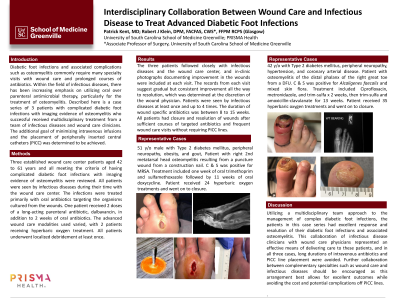Back

Case Series/Study
(CS-071) Interdisciplinary Collaboration Between Wound Care and Infectious Diseases to Treat Advanced Diabetic Foot Infections

Co-Author(s):
Patrick Kent, MD – ID Fellow, Infectious Disease, Prisma Health
<b>Introduction</b>: <p style="margin: 0in 0in 8pt;"><span style="font-family: Calibri; font-size: medium;">Diabetic foot infections and associated complications such as osteomyelitis commonly require many specialty visits with wound care and prolonged courses of antibiotics. Within the field of infectious diseases, there has been increasing emphasis on utilizing oral over parenteral antimicrobial therapy, particularly for the treatment of osteomyelitis. Described here is a case series of 3 patients with complicated diabetic foot infections with imaging evidence of osteomyelitis who successfully received multidisciplinary treatment from a team infectious diseases and wound care clinicians. The additional goal of minimizing intravenous infusions and the placement of peripherally inserted central catheters (PICC) was determined to be achieved. </span></p><br/><br/><b>Methods</b>: <p style="margin: 0in 0in 8pt;"><span style="font-family: Calibri; font-size: medium;">Three established wound care center patients aged 42 to 61 years and all meeting the criteria of having complicated diabetic foot infections with imaging evidence of osteomyelitis were reviewed. All patients were seen by infectious diseases during their time with the wound care center. The infections were treated primarily with oral antibiotics targeting the organisms cultured from the wounds. One patient received 2 doses of a long-acting parenteral antibiotic, dalbavancin, in addition to 2 weeks of oral antibiotics. The advanced wound care modalities used varied, with 2 patients receiving hyperbaric oxygen treatment. All patients underwent localized debridement at least once.</span></p><br/><br/><b>Results</b>: <p style="margin: 0in 0in 8pt;"><span style="font-family: Calibri; font-size: medium;">The three patients followed closely with infectious diseases and the wound care center, and in-clinic photographs documenting improvement in the wounds were included at each visit. The records from each visit suggest gradual but consistent improvement all the way to resolution, which was determined at the discretion of the wound physician. Patients were seen by infectious diseases at least once and up to 4 times. The duration of wound specific antibiotics was between 8 to 15 weeks. All patients had closure and resolution of wounds after sufficient courses of targeted antibiotics and frequent wound care visits without requiring PICC lines.</span></p><br/><br/><b>Discussion</b>: <p style="margin: 0in 0in 8pt;"><span style="font-family: Calibri; font-size: medium;">Utilizing a multidisciplinary approach to the management of complex diabetic foot infections, the patients in this case series had excellent response and resolution of their diabetic foot infections and associated osteomyelitis. This collaboration of infectious disease clinicians with wound care physicians represented an effective means of delivering care to these patients, and in all three cases, long durations of intravenous antibiotics and PICC line placement were avoided. Further collaboration between complementary specialties such as wound care and infectious diseases should be encouraged as this arrangement best allows for excellent outcomes while avoiding the cost and potential complications of PICC lines.</span></p><br/><br/><b>Trademarked Items</b>: <br/><br/><b>References</b>: <br/><br/>

.png)